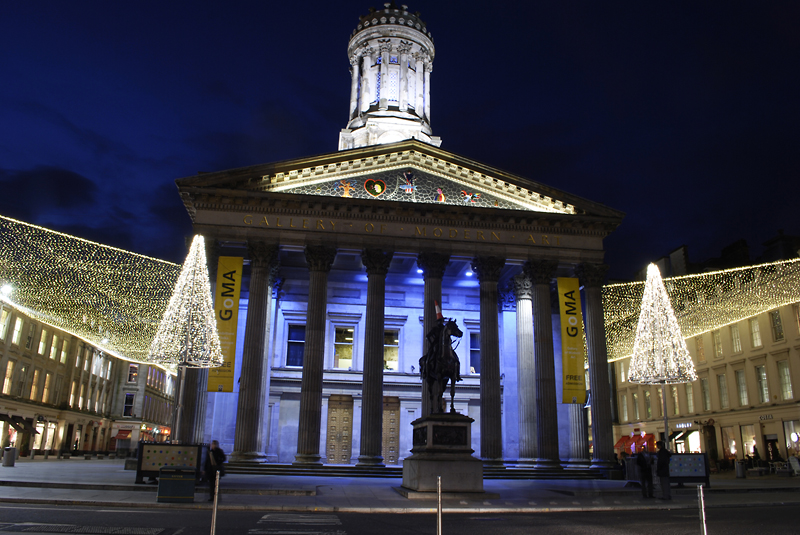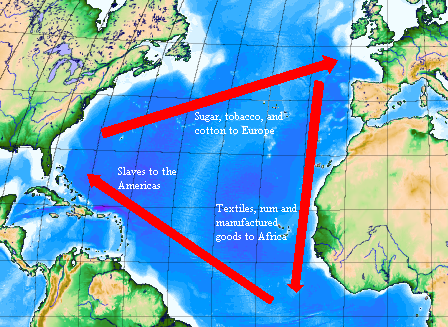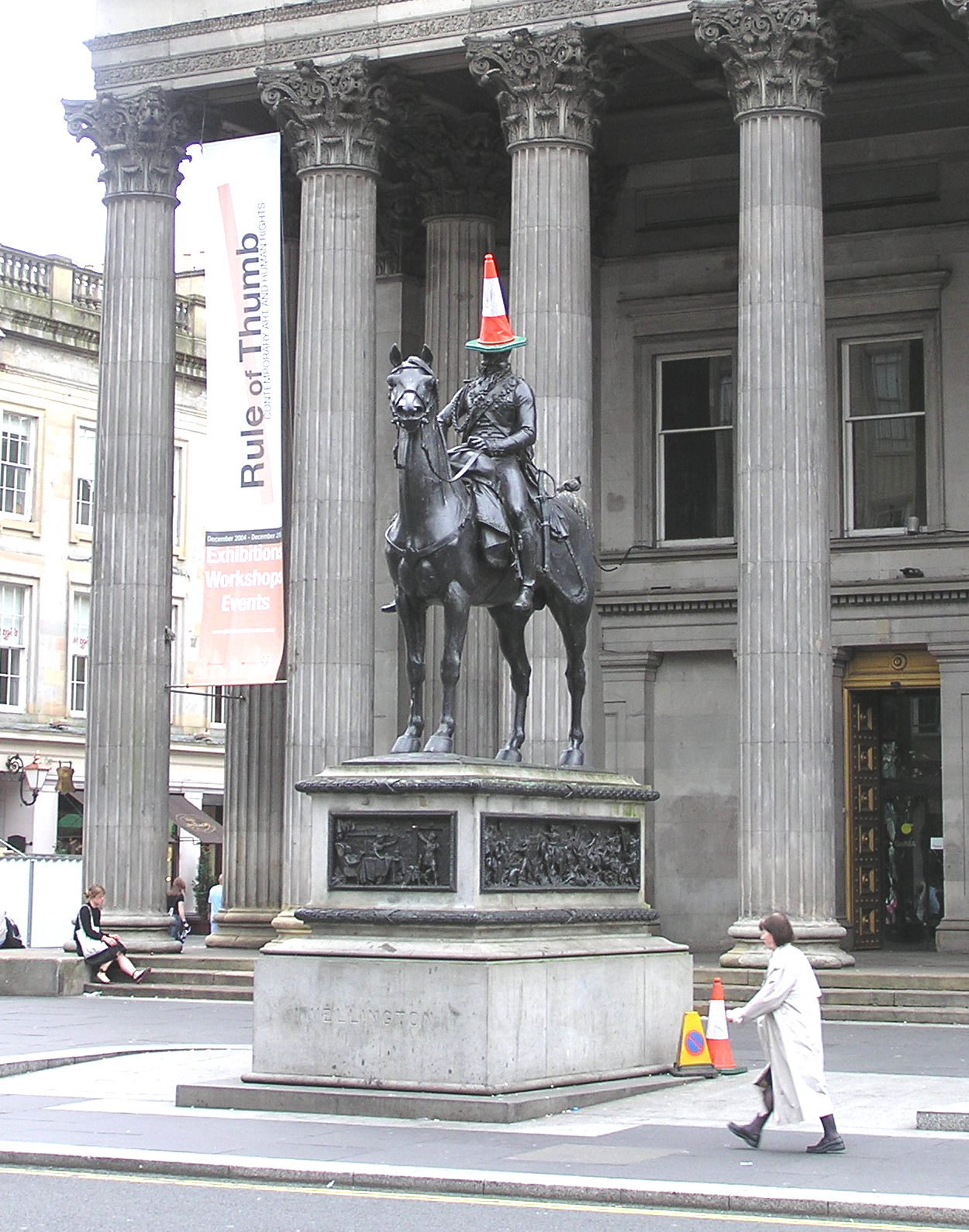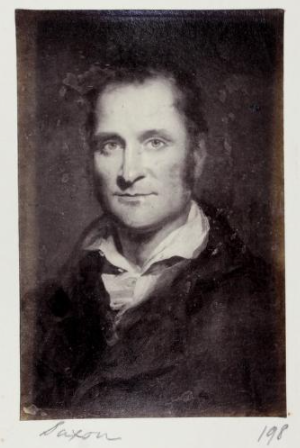|
Royal Exchange Square
The Royal Exchange Square is a public square in Glasgow, Scotland. The square lies between Buchanan Street and Queen Street, opening out Queen Street and Ingram Street to the south of George Square. It is also easily accessible from Buchanan Street on the west side of the square, through two prominent archways at Royal Bank Place. The square is a landmark due to its distinguished architecture which attracts many visitors. It is one of six squares in the city centre. Historical background Tobacco lord William Cunninghame's mansion and gardens fronting Queen Street, and central to the future square, were constructed in 1778 when the wealth of Glasgow soon eclipsed the remainder of Scotland. Five years later the Royal Bank of Scotland opened in Glasgow, being its first ever branch beyond its Edinburgh base. Under its agent, the merchant and philanthropist David Dale, the bank in Glasgow soon exceeded the business volume of the Royal Bank elsewhere, and to reflect its statu ... [...More Info...] [...Related Items...] OR: [Wikipedia] [Google] [Baidu] |
Tobacco Lords
The Tobacco Lords were a group of Scottish merchants and slave traders who in the 18th century made enormous fortunes by trading in tobacco. Many became so wealthy that they adopted the lifestyle of aristocrats, lavishing vast sums on great houses and splendid churches. History In 1707, the Treaty of Union between Scotland and England gave Scottish merchants access to the English colonies, especially in North America. Glasgow's position on the River Clyde, where the westerlies hit Europe as well as in other places like Bristol, Nantes, or Bordeaux, may have been an opportunity for its merchants. The French monarchy granted to Glasgow in 1747 a monopoly for the importation of tobacco into French territories. The deepening of the Clyde in 1768 provided a further advantage, because Glasgow ships were built specifically for the Atlantic crossing and were generally bigger than those of other ports. The tobacco trade was part of broader trade that linked exports of consumer and ma ... [...More Info...] [...Related Items...] OR: [Wikipedia] [Google] [Baidu] |
Carlo Marochetti
Baron Pietro Carlo Giovanni Battista Marochetti (14 January 1805 – 29 December 1867) was an Italian-born French sculptor who worked in France, Italy and Britain. He completed many public sculptures, often in a neo-classical style, plus reliefs, memorials and large equestrian monuments in bronze and marble. In 1848, Marochetti settled in England, where he received commissions from Queen Victoria. Marochetti received great recognition during his lifetime, being made a baron in Italy and was awarded the Legion of Honour by the French government. Biography Early life Carlo Marochetti was born in Turin, where his father, Vincenzo, a former priest, was a local government official and professor of eloquence at Turin University, but after the family moved to Paris, Carlo was brought up as a French citizen. He studied at the Lycée Napoléon and then studied sculpture at the École des Beaux-Arts in Paris where his teachers were François Joseph Bosio and Antoine-Jean Gros. At ... [...More Info...] [...Related Items...] OR: [Wikipedia] [Google] [Baidu] |
Blythswood Square
Blythswood Square is the Georgian square on Blythswood Hill in the heart of the City of Glasgow, Scotland. The square is part of the 'Magnificent New Town of Blythswood' built in the 1800s on the rising empty ground west of a very new Buchanan Street. These open grounds were part of the vast Lands of Blythswood stretching to the River Kelvin acquired by the Douglas-Campbell family in the 17th century.''Glasgow Past and Present''; by Senex and others, three volumes published in 1884 The Blythswood district became a Conservation Area in 1970, because of its important architectural and historic buildings. The square is one of the largest residential developments on Blythswood Hill on the of ground purchased in 1802 from the Campbells of Blythswood by The Great Improver - William Harley textile manufacturer and merchant. Harley also owned the adjacent mansion and 10-acre estate of Willow Bank, where he created and opened his Willowbank/Blythswood Pleasure Gardens with view ... [...More Info...] [...Related Items...] OR: [Wikipedia] [Google] [Baidu] |
Gallery Of Modern Art, Glasgow
The Gallery of Modern Art (GoMA) is the main gallery of contemporary art in Glasgow, Scotland. GoMA offers a programme of temporary exhibitions and workshops. GoMA displays work by local and international artists as well as addressing contemporary social issues through its major biannual projects. History Opened in 1996, the Gallery of Modern Art is housed in a neoclassical building in Royal Exchange Square in the heart of Glasgow city centre. Built in 1778 as the townhouse of William Cunninghame of Lainshaw, a wealthy Glasgow Tobacco Lord who made his fortune through the triangular slave trade, the building has undergone a series of different uses. It was bought in 1817 by the Royal Bank of Scotland who later moved onto Buchanan Street; it then became the Royal Exchange. Reconstruction for this use was undertaken by David Hamilton between 1827 and 1832 and resulted in many additions to the building, namely the Corinthian pillars to the Queen Street facade, the cupola above ... [...More Info...] [...Related Items...] OR: [Wikipedia] [Google] [Baidu] |
Arthur Wellesley, 1st Duke Of Wellington
Arthur Wellesley, 1st Duke of Wellington, (1 May 1769 – 14 September 1852) was an Anglo-Irish people, Anglo-Irish soldier and Tories (British political party), Tory statesman who was one of the leading military and political figures of United Kingdom of Great Britain and Ireland, 19th-century Britain, serving twice as prime minister of the United Kingdom. He is among the commanders who won and ended the Napoleonic Wars when the coalition defeated Napoleon at the Battle of Waterloo in 1815. Wellesley was born in Dublin into the Protestant Ascendancy in Kingdom of Ireland, Ireland. He was commissioned as an Ensign (rank), ensign in the British Army in 1787, serving in Ireland as aide-de-camp to two successive lords lieutenant of Ireland. He was also elected as a Member of Parliament (United Kingdom), member of Parliament in the Irish House of Commons. He was a colonel by 1796 and saw Flanders Campaign, action in the Netherlands and in India, where he fought in the Fourth Angl ... [...More Info...] [...Related Items...] OR: [Wikipedia] [Google] [Baidu] |
David Hamilton (architect)
David Hamilton (11 May 1768 – 5 December 1843) was a Scottish architect based in Glasgow. He has been called the "father of the profession" in Glasgow. Career Notable works include Hutchesons' Hall, Nelson Monument in Glasgow Green and Lennox Castle. The Royal Exchange in Queen Street is David Hamilton's best known building in Glasgow. It was completed in 1829, built around an existing mansion house dating from 1778. It now serves as the city's Gallery of Modern Art. In 1835, Hamilton came third in the competition to design the Houses of Parliament (London) and won £500. He was the only Scottish architect to win a prize for his entry. He is known to have been sculpted by both William Mossman and Patric Park. Thomas Gildard and John Thomas Rochead were trained by him. He was father-in-law to the architect James Smith and maternal grandfather of the infamous Madeleine Smith. Gallery of his work Image:Wfm goma glasgow.jpg, Façade of the Gallery of Modern Art ... [...More Info...] [...Related Items...] OR: [Wikipedia] [Google] [Baidu] |
David Dale
David Dale (6 January 1739–7 March 1806) was a leading Scottish industrialist, merchant and philanthropist during the Scottish Enlightenment period at the end of the 18th century. He was a successful entrepreneur in a number of areas, most notably in the cotton-spinning industry, and was the founder of the cotton mills in New Lanark, where he provided social and educational conditions far in advance of anything available anywhere else in the UK. New Lanark attracted visitors from all over the world. Robert Owen, who married Dale’s daughter, Caroline, in 1799, used New Lanark to develop his theories about communitarian living, education and character formation. Scottish historian, Tom Devine, described Dale as ‘the greatest cotton magnate of his time in Scotland’. Early career Dale was born in Stewarton, Ayrshire on 6 January 1739, son of William Dale (1708–1796), a general dealer in the village, and Martha Dunlop (1719–1796). His date of birth is normally gi ... [...More Info...] [...Related Items...] OR: [Wikipedia] [Google] [Baidu] |
Royal Bank Of Scotland
The Royal Bank of Scotland plc (RBS; gd, Banca Rìoghail na h-Alba) is a major retail and commercial bank in Scotland. It is one of the retail banking subsidiaries of NatWest Group, together with NatWest (in England and Wales) and Ulster Bank. The Royal Bank of Scotland has around 700 branches, mainly in Scotland, though there are branches in many larger towns and cities throughout England and Wales. The bank is completely separate from the fellow Edinburgh-based bank, the Bank of Scotland, which pre-dates the Royal Bank by 32 years. The Royal Bank of Scotland was established in 1724 to provide a bank with strong Hanoverian and Whig ties. Following ring-fencing of the Group's core domestic business, the bank became a direct subsidiary of NatWest Holdings in 2019. NatWest Markets comprises the Group's investment banking arm. To give it legal form, the former RBS entity was renamed NatWest Markets in 2018; at the same time Adam and Company (which held a separate PRA b ... [...More Info...] [...Related Items...] OR: [Wikipedia] [Google] [Baidu] |
George Square
George Square ( gd, Ceàrnag Sheòrais) is the principal civic square in the city of Glasgow, Scotland. It is one of six squares in the city centre, the others being Cathedral Square, St Andrew's Square, St Enoch Square, Royal Exchange Square, and Blythswood Square on Blythswood Hill. Named after King George III and initially laid out in 1781 but not developed for another twenty years, George Square is surrounded by architecturally important buildings including on the east side the palatial Municipal Chambers, also known as the City Chambers, whose foundation stone was laid in 1883, and on the west side by the . Built by Glasgow Corporation, the Chambers are the continuing headquarters of Glasgow City Council. Joseph Swan's panoramic engraving of 1829 shows the early development of the square and its surrounding buildings. The square boasts an important collection of statues and monuments, including those dedicated to Robert Burns, James Watt, Sir Robert Peel and Sir ... [...More Info...] [...Related Items...] OR: [Wikipedia] [Google] [Baidu] |
Royal Exchange Square - Geograph
Royal may refer to: People * Royal (name), a list of people with either the surname or given name * A member of a royal family Places United States * Royal, Arkansas, an unincorporated community * Royal, Illinois, a village * Royal, Iowa, a city * Royal, Missouri, an unincorporated community * Royal, Nebraska, a village * Royal, Franklin County, North Carolina, an unincorporated area * Royal, Utah, a ghost town * Royal, West Virginia, an unincorporated community * Royal Gorge, on the Arkansas River in Colorado * Royal Township (other) Elsewhere * Mount Royal, a hill in Montreal, Canada * Royal Canal, Dublin, Ireland * Royal National Park, New South Wales, Australia Arts, entertainment, and media * ''Royal'' (Jesse Royal album), a 2021 reggae album * ''The Royal'', a British medical drama television series * ''The Royal Magazine'', a monthly British literary magazine published between 1898 and 1939 * ''Royal'' (Indian magazine), a men's lifestyle bimonthly * Royal ... [...More Info...] [...Related Items...] OR: [Wikipedia] [Google] [Baidu] |
Ingram Street
Ingram Street is a major thoroughfare in the city of Glasgow, the largest city in Scotland. The street runs east from Queen Street through the Merchant City until it meets High Street. History The street was formerly known as Back Cow Lone. Lone or Loan being an old Scots word for a cattle track or lane, which then also became used as a street name. Re-naming of the street Back Cow Lone was re-named to Ingram Street in 1781. The street was re-named in honour of Archibald Ingram, a Tobacco Lord, who became Lord Provost of Glasgow in the 1760s. Landmarks At the western end of the street at the junction with Queen Street is the Gallery of Modern Art in Royal Exchange Square. There are several local landmarks on Ingram Street itself, such as the Italian Centre, the old Sheriff Court, Ramshorn Theatre, the Hutchesons' Hall and the amongst others. Ingram Street has, in recent years, became a haven for upmarket retailers such as Polo Ralph Lauren, who operate their only UK ... [...More Info...] [...Related Items...] OR: [Wikipedia] [Google] [Baidu] |


.jpg)







